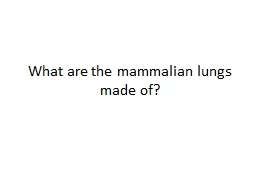PPT-What are the
Author : sherrill-nordquist | Published Date : 2016-05-27
mammalian lungs made of Success Criteria Describe with the aid of diagrams and photographs the distribution of cartilage ciliated epithelium goblet cells smooth
Presentation Embed Code
Download Presentation
Download Presentation The PPT/PDF document "What are the" is the property of its rightful owner. Permission is granted to download and print the materials on this website for personal, non-commercial use only, and to display it on your personal computer provided you do not modify the materials and that you retain all copyright notices contained in the materials. By downloading content from our website, you accept the terms of this agreement.
What are the: Transcript
Download Rules Of Document
"What are the"The content belongs to its owner. You may download and print it for personal use, without modification, and keep all copyright notices. By downloading, you agree to these terms.
Related Documents

